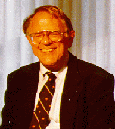C. Gordon Bell
 principal papers hardware software keywords see also related subjects |
Achievement
While working for Digital Equipment Corporation (DEC) in the 1960s, Gordon Bell helped build the PDP series of minicomputers, the first minicomputers introduced to the commercial data processing market. He also oversaw the development of one of the industryís most successful computer lines, DECís VAX series. He is currently one of several experts employed by Microsoft to direct that companyís future path. Biography Bell was born on August 19, 1934 in Kirksville, Missouri. He received a B.S. and M.S. in electrical engineering from the Massachusetts Institute of Technology (MIT) in 1956 and 1957, respectively. After receiving his masterís degree, he worked at MITís Engineering Speech Communications Laboratory. During his time at MIT, Bell knew two other MIT computer engineers named Ken Olsen and Harlan Anderson and decided to start their own company, Digital Equipment Corporation. By 1959 Olsen and Anderson were starting to build a new, smaller computer that was the precursor to the minicomputer. Bell was asked to join DEC as an engineer in 1960, where he began work on the early Program Data Processor (PDP) minicomputers. His work on the PDPs contributed to Bell becoming an industry-recognized expert on minicomputers and interactive computing. In 1966, he left DEC to teach computer science at Carnegie-Mellon University. While there, he also worked on minicomputer-related interactive computing. In 1972, he was convinced to return to DEC as vice-president of engineering to oversee the production of the VAX (Virtual Address Extension) line of minicomputers and move the company into the world of semiconductor (chip) technology. The 32-bit VAX minicomputers went on to become some of the most successful computers ever created and completely changed the face of the minicomputer industry. Bell remained with DEC until his retirement in 1983, which was prompted by a heart attack. In July 1983, he started a new company with Kenneth Fisher and Henry Burkhardt called Encore Computer Corporation. Their intention was to build a new generation of small computers and to help new start-up companies. He then spent the late 1980s leading the National Science Foundationís Information Superhighway initiative and co-writing a book on venture capital called High Tech Ventures: The Guide for Entrepreneurial Success. The early 1990s found Bell helping several small start-up companies where he served in various positions, including chief scientist at Stardent Computer in Newton, Massachusetts in 1990 and vice-president of Research and Development at Ardent Corporation in Sunnyvale, California in 1991. He was also a director of the Bell-Mason Group, which programmed computers to analyze the strengths and weaknesses of new businesses. From 1991 to 1995, Bell acted as an advisor to Microsoft for future development efforts and helped set up its first research laboratory. Microsoft was trying to become the research power that would dictate the next decadeís computer technology. To this point, it tempted some of the best minds in the industry to join in its long-term research and development. In August 1995, Bell officially joined this brain trust. Through his association with Microsoft, Bell plans to explore the use of video and high-speed networks to expand and facilitate human-human interactions and to reduce physical travel, fields known as "telepresence" or "telecomputing." He is also exploring what he calls "scalable network and platform computing (SNAP)," a new architecture that would give a single desktop operator the same operating power as a mainframe, something he believes is feasible shortly after the turn of the century. In addition to his work in the computer field, Bell published several books and helped establish the Computer Museum in Boston. He also received several awards for his contributions to the computer industry, including the National Medal of Technology in 1991 and the Eckert-Mauchly award in 1982, named after the two developers of ENIAC and UNIVAC. In 1986, the National Science Foundation asked him to direct funding for U.S. computer science efforts. As the first assistant director for computing at the National Science Foundation, he led the National Research Network panel that became the National Information Infrastructure/Global Information Infrastructure (NII/GII) and helped write the High-Performance Computer and Communications Initiative. While many of the pioneers in the computer industry have fallen by the wayside, either of their own volition or because the industry moved away from them, Gordon Bell has remained always at the forefront. He isnít sitting back resting on his laurels or pining for the good old days. One reason he agreed to join Microsoft is to "continue to be a part of the next paradigm shift."
Related links Chronology
|
![]()
| Last Updated on June 4, 2002 | For suggestions please mail the editors |
Footnotes & References
| 1 | courtesy: Jones International and Jones Digital Century |
| 2 | |
| 3 |